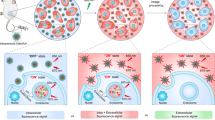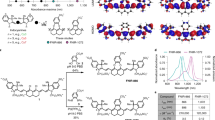Abstract
We describe the development of multifunctional nanoparticle probes based on semiconductor quantum dots (QDs) for cancer targeting and imaging in living animals. The structural design involves encapsulating luminescent QDs with an ABC triblock copolymer and linking this amphiphilic polymer to tumor-targeting ligands and drug-delivery functionalities. In vivo targeting studies of human prostate cancer growing in nude mice indicate that the QD probes accumulate at tumors both by the enhanced permeability and retention of tumor sites and by antibody binding to cancer-specific cell surface biomarkers. Using both subcutaneous injection of QD-tagged cancer cells and systemic injection of multifunctional QD probes, we have achieved sensitive and multicolor fluorescence imaging of cancer cells under in vivo conditions. We have also integrated a whole-body macro-illumination system with wavelength-resolved spectral imaging for efficient background removal and precise delineation of weak spectral signatures. These results raise new possibilities for ultrasensitive and multiplexed imaging of molecular targets in vivo.
This is a preview of subscription content, access via your institution
Access options
Subscribe to this journal
Receive 12 print issues and online access
$209.00 per year
only $17.42 per issue
Buy this article
- Purchase on SpringerLink
- Instant access to full article PDF
Prices may be subject to local taxes which are calculated during checkout






Similar content being viewed by others
References
Chan, W.C.W. et al. Luminescent QDs for multiplexed biological detection and imaging. Curr. Opin. Biotechnol. 13, 40–46 (2002).
Bruchez, M., Jr, Moronne, M., Gin, P., Weiss, S. & Alivisatos, A.P. Semiconductor nanocrystals as fluorescent biological labels. Science 281, 2013–2015 (1998).
Chan, W.C.W. & Nie, S.M. Quantum dot bioconjugates for ultrasensitive nonisotopic detection. Science 281, 2016–2018 (1998).
Mattoussi, H. et al. Self-assembly of CdSe-ZnS quantum dot bioconjugates using an engineered recombinant protein. J. Am. Chem. Soc. 122, 12142–12150 (2000).
Akerman, M.E., Chan, W.C.W., Laakkonen, P., Bhatia, S.N. & Ruoslahti, E. Nanocrystal targeting in vivo. Proc. Natl. Acad. Sci. USA 99, 12617–12621 (2002).
Dubertret, B. et al. In vivo imaging of QDs encapsulated in phospholipid micelles. Science 298, 1759–1762 (2002).
Wu, X.Y. et al. Immunofluorescent labeling of cancer marker Her2 and other cellular targets with semiconductor QDs. Nat. Biotechnol. 21, 41–46 (2003).
Jaiswal, J.K., Mattoussi, H., Mauro, J.M. & Simon, S.M. Long-term multiple color imaging of live cells using quantum dot bioconjugates. Nat. Biotechnol. 21, 47–51 (2003).
Larson, D.R. et al. Water-soluble quantum dots for multiphoton fluorescence imaging in vivo. Science 300, 1434–1436 (2003).
Ishii, D. et al. Chaperonin-mediated stabilization and ATP-triggered release of semiconductor nanoparticles. Nature 423, 628–632 (2003).
Medintz, I.L. et al. Self-assembled nanoscale biosensors based on quantum dot FRET donors. Nat. Mater. 2, 630–639 (2003).
Dahan, M. et al. Diffusion dynamics of glycine receptors revealed by single–quantum dot tracking. Science 302, 442–445 (2003).
Rosenthal, S.J. et al. Targeting cell surface receptors with ligand-conjugated nanocrystals. J. Am. Chem. Soc. 124, 4586–4594 (2002).
Niemeyer, C.M. Nanoparticles, proteins, and nucleic acids: biotechnology meets materials science. Angew. Chem. Int. Ed. Engl. 40, 4128–4158 (2001).
Alivisatos, A.P. Semiconductor clusters, nanocrystals, and quantum dots. Science 271, 933–937 (1996).
Han, M.Y., Gao, X.H., Su, J.Z. & Nie, S.M. Quantum dot-tagged microbeads for multiplexed optical coding of biomolecules. Nat. Biotechnol. 19, 631–635 (2001).
Gao, X.H. & Nie, S.M. Doping mesoporous materials with multicolor quantum dots. J. Phys. Chem. B. 107, 11575–11578 (2003).
Gao, X.H. & Nie, S.M. Quantum dot-encoded mesoporous beads with high brightness and uniformity: rapid readout using flow cytometry. Anal. Chem. 76, 2406–2410 (2004).
Josephson, L., Kircher, M.F., Mahmood, U., Tang, Y. & Weissleder, R. Near-infrared fluorescent nanoparticles as combined MR/optical imaging probes. Bioconjug. Chem. 13, 554–560 (2002).
Gao, X.H. & Nie, S.M. Molecular profiling of single cells and tissue specimens with quantum dots. Trends Biotechnol. 21, 371–373 (2003).
Jovin, T.M. Quantum dots finally come of age. Nat. Biotechnol. 21, 32–33 (2003).
Lim, Y.T. et al. Selection of quantum dot wavelengths for biomedical assays and imaging. Mol. Imaging 2, 50–64 (2003).
Ballou, B., Lagerholm, B.C., Ernst, L.A., Bruchez, M.P. & Waggoner, A.S. Noninvasive imaging of quantum dots in mice. Bioconjug. Chem. 15, 79–86 (2004).
Kim, S. et al. Near-infrared fluorescent type II quantum dots for sentinel lymph node mapping. Nat. Biotechnol. 22, 93–95 (2004).
Lidke, D.S. et al. Quantum dot ligands provide new insights into erbB/HER receptor–mediated signal transduction. Nat. Biotechnol. 22, 198–203 (2004).
Savic, R., Luo, L.B., Eisenberg, A. & Maysinger, D. Micellar nanocontainers distribute to defined cytoplasmic organelles. Science 300, 615–618 (2003).
Allen, C., Maysinger, D. & Eisenberg, A. Nano-engineering block copolymer aggregates for drug delivery. Colloids Surf. B Biointerfaces 16, 3–27 (1999).
Ludwigs, S. et al. Self-assembly of functional nanostructures from ABC triblock copolymers. Nat. Mater. 2, 744–747 (2003).
Ness, J.M., Akhtar, R.S., Latham, C.B. & Roth, K.A. Combined tyramide signal amplification and quantum dots for sensitive and photostable immunofluorescence detection. J. Histochem. Cytochem. 51, 981–987 (2003).
Nirmal, M. et al. Fluorescence intermittency in single cadmium selenide nanocrystals Nature 383, 802–804 (1996).
Empedocles, S.A. & Bawendi, M.G. Quantum-confined stark effect in single CdSe nanocrystallite quantum dots. Science 278, 2114–2117 (1997).
Kirpotin, D. et al. Sterically stabilized anti-HER2 immunoliposomes: design and targeting to human breast cancer cell in vitro. Biochemistry 36, 66–75 (1997).
Duncan, R. The dawning era of polymer therapeutics. Nat. Rev. Drug Discov. 2, 347–360 (2003).
Jain, R.K. Transport of molecules, particles, and cells in solid tumors. Ann. Rev. Biomed. Eng. 1, 241–263 (1999).
Jain, R.K. Delivery of molecular medicine to solid tumors: lessons from in vivo imaging of gene expression and function. J. Control. Release 74, 7–25 (2001).
Chang, S.S., Reuter, V.E., Heston, W.D.W. & Gaudin, P.B. Metastatic renal cell carcinoma neovasculature expresses prostate-specific membrane antigen. Urology 57, 801–805 (2001).
Schulke, N. et al. The homodimer of prostate-specific membrane antigen is a functional target for cancer therapy. Proc. Natl. Acad. Sci. USA 100, 12590–12595 (2003).
Bander, N.H. et al. Targeting metastatic prostate cancer with radiolabeled monoclonal antibody J591 to the extracellular domain of prostate specific membrane antigen. J. Urol. 170, 1717–1721 (2003).
Wunderbaldinger, P., Josephson, L. & Weissleder, R. Tat peptide directs enhanced clearance and hepatic permeability of magnetic nanoparticles. Bioconjug. Chem. 13, 264–268 (2002).
Campbell, R.B. et al. Cationic Charge Determines the Distribution of Liposomes between the Vascular and Extravascular Compartments of Tumors. Cancer Res. 62, 6831–6836 (2002).
Levenson, R.M. Spectral imaging and pathology: seeing more. Lab. Med. 35, 244–251 (2004).
Yang, M. et al. Direct external imaging of nascent cancer, tumor progression, angiogenesis, and metastasis on internal organs in the fluorescent orthotopic model. Proc. Natl. Acad. Sci. USA 99, 3824–3829 (2002).
Lewin, M. et al. Tat peptide-derivatized magnetic nanoparticles allow in vivo tracking and recovery of progenitor cells. Nat. Biotechnol 18, 410–414 (2000).
Randolph, G.J., Inaba, K., Robbiani, D.F., Steinman, R.M. & Muller, W.A. Differentiation of phagocytic monocytes into lymph node dendritic cells in vivo. Immunity 11, 753–761 (1999).
Hess, B.C. et al. Surface transformation and photoinduced recovery in CdSe nanocrystals. Phys. Rev. Lett. 86, 3132–3135 (2001).
Manna, L., Scher, E.C., Li, L.-S. & Alivisatos, A.P. Epitaxial growth and photochemical annealing of graded CdS/ZnS shells on colloidal CdSe nanorods. J. Am. Chem. Soc. 124, 7136–7145 (2002).
Mammen, M., Choi, S.K. & Whitesides, G.M. Polyvalent interactions in biological systems: implications for design and use of multivalent ligands and inhibitors. Angew. Chem. Int. Edn Engl. 37, 2754–2794 (1998).
Jin, R., Wu, G., Li, Z. & Mirkin, C.A. & Schatz, G.C. What controls the melting properties of DNA-linked gold nanoparticle assemblies. J. Am. Chem. Soc. 125, 1643–1654 (2003).
Cheong, W.F., Prahl, S.A. & Welch, A.J. A review of the optical properties of biological tissues. IEEE J. Quantum Electron. 26, 2166–2185 (1990).
Ntziachristos, V., Bremer, C. & Weissleder, R. Fluorescence imaging with near-infrared light: new technological advances that enable in vivo molecular imaging. Eur. Radiol. 13, 195–208 (2003).
Bailey, R.E. & Nie, S.M. Alloyed semiconductor QDs: tuning the optical properties without changing the particle size. J. Am. Chem. Soc. 125, 7100–7106 (2003).
Kim, S., Fisher, B., Eisler, H.J. & Bawendi, M.G. Type-II quantum dots: CdTe/CdSe (core/shell) and CdSe/ZnTe (core/shell) heterostructures. J. Am. Chem. Soc. 125, 11466–11467 (2003).
Derfus, A.M., Chan, W.C.W. & Bhatia, S.N. Probing the cytotoxicity of semiconductor quantum dots. Nano Lett. 4, 11–18 (2004).
Peng, Z.A. & Peng, X. Formation of high-quality CdTe, CdSe, and CdS nanocrystals using CdO as precursor. J. Am. Chem. Soc. 123, 183–184 (2001).
Qu, L.H., Peng, Z.A. & Peng, X. Alternative routes toward high quality CdSe nanocrystals. Nano Lett. 1, 333–337 (2001).
Hsieh, C.L. et al. Improved gene-expression by a modified bicistronic retroviral vector. Biochem. Bioph. Res. Commun. 214, 910–917 (1995).
Acknowledgements
This work was supported by grants to S.N. and L.W.K.C. from the National Institutes of Health (R01 GM60562 to S.N. and P01 CA098912 to L.W.K.C.), the Georgia Cancer Coalition (Distinguished Cancer Scholar Awards), the Coulter Translational Research Program at Georgia Tech and Emory University and the Department of Defense (17-03-2-0033 to L.W.K.C.). We acknowledge Lily Yang and Binfei Zhou for technical help, and Fray F. Marshall, John A. Petros, Hyunsuk Shim and Jonathan W. Simons for stimulating discussions. We are also grateful to Millennium Pharmaceuticals for providing the PSMA monoclonal antibody (J591).
Author information
Authors and Affiliations
Corresponding authors
Ethics declarations
Competing interests
The authors declare no competing financial interests.
Supplementary information
Supplementary Fig. 1
Comparison of red-emitting QDs and red organic dyes for in vivo optical imaging. (PDF 54 kb)
Supplementary Fig. 2
Comparison of mouse skin and QD emission spectra. (PDF 159 kb)
Rights and permissions
About this article
Cite this article
Gao, X., Cui, Y., Levenson, R. et al. In vivo cancer targeting and imaging with semiconductor quantum dots. Nat Biotechnol 22, 969–976 (2004). https://doi.org/10.1038/nbt994
Received:
Accepted:
Published:
Issue Date:
DOI: https://doi.org/10.1038/nbt994



